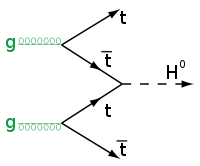
From “Large Hadron Collider Experiments Eliminate More Higgs Hiding Spots” (ScienceDaily, Aug. 23, 2011), we learn:
Two experimental collaborations at the Large Hadron Collider, located at CERN laboratory near Geneva, Switzerland, announced that they have significantly narrowed the mass region in which the Higgs boson could be hiding.
It’s actually happening faster than many expected:
Higgs boson could be ruled out as particle by end of next year (July 25, 2011)
The good news is that physics works. Evidence: You can actually find out something, even if it wasn’t what you wanted to hear.
The ATLAS and CMS experiments excluded with 95 percent certainty the existence of a Higgs over most of the mass region from 145 to 466 GeV.
The Higgs particle is the last not-yet-observed piece of the theoretical framework known as the Standard Model of particles and forces. According to the Standard Model, the Higgs boson explains why some particles have mass and others do not.
“These are exciting times for particle physics,” said CERN’s research director, Sergio Bertolucci. “Discoveries are almost assured within the next twelve months. If the Higgs exists, the LHC experiments will soon find it. If it does not, its absence will point the way to new physics.”
Will it? Does that mean an end to crackpot cosmologies? Too soon to tell. Won’t they need to continue generating crackpot cosmologies for the pop science press?
See also: Connaisseur’s guide to pop science: If it mentions “space wormholes,” it’s not serious
